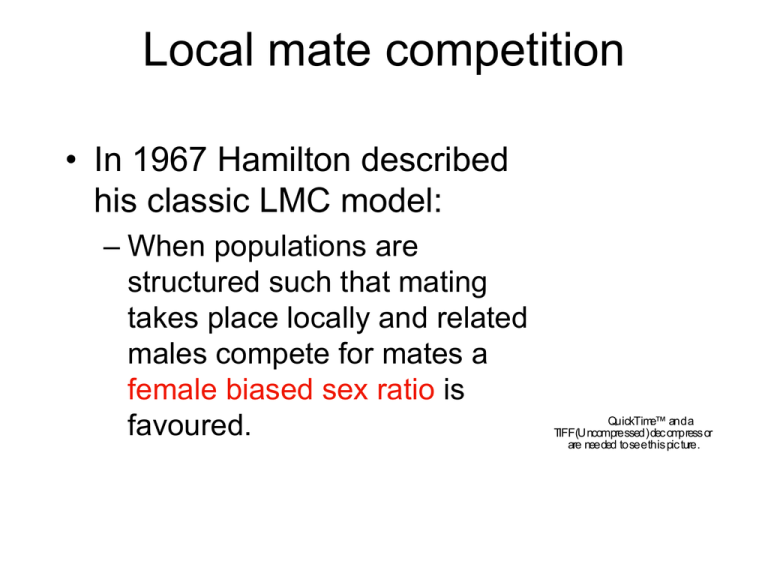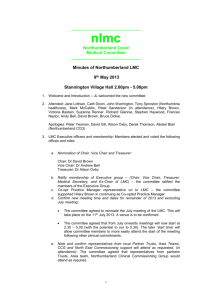
Local mate competition
• In 1967 Hamilton described
his classic LMC model:
– When populations are
structured such that mating
takes place locally and related
males compete for mates a
female biased sex ratio is
favoured.
QuickTime™ and a
TIFF(Uncompressed) decompressor
are needed to see this picture.
:
:
?
Quic kT ime™ and a
T IFF (Uncompress ed) decompress or
are needed to s ee this pi cture.
Reasoning
•
Inclusive fitness:
– Competition between related males,
reduces the fitness returns for producing
males
– Some of males mate with their sister,
which increases the fitness return from
producing daughters
Reasoning
QuickTime™ and a
TIFF(Uncompressed) decompressor
are needed to see this picture.
H
• Group selection theory:
H
H
Grandchildren:
24
Total: 48
24
H
F
F
Grandchildren:
18.7
Total: 40
Qu ickT ime™ an d a
TIF F (U ncom pre ssed ) dec omp ress or
are nee ded to se e thi s pic ture .
21.3
F
F
Grandchildren:
16
16
Total: 32
ESS sex ratio determined by relative strength of within/between group
selection, influenced by N!!
CAN ONLY GROUP SELECTION EXPLAIN LMC?
Haplodiploidy
• In haplodiploids an extra factor favours
female biased SR
• Sons are haploid, daughters diploid
• Sibmating increases relatedness between
mother and daughters, no effect R sons
• Inbreeding leads to more females biased
ESS SR
Sibmating directly influences LMC and in only haplodiploids it
has an additional effect on SR
LMC under different scenarios
sex ratio (% males)
0.6
0.5
0.4
0.3
D iploid
0.2
H aplodiploid inbreeding
depends on N
0.1
H aplodiploid fixed
s ibmating k=0 .5
H aplodiploid c omplete
s ibmating k=1 .0
0
0
5
10
15
20
number of foundresses
25
30
Qu ickT ime™ and a
TIF F (U ncom pres sed) deco mpre ssor
are nee ded t o see this pict ure.
Support for LMC
LMC has been applied to explain female
biased SR adjustment in many species
– Comparative studies: compare sr across
species/population that differ in LMC
– Directly testing facultative sex ratio
adjustment
QuickTime™ and a
TIFF(Uncompres sed) dec ompressor
QuickTime™ and a
Quic kT ime™ and a
Quic kT ime™ and a
are needed to see thi s pic ture.
QuickTime™ and a
Quick Time™ an d a
T IFF (Uncompressed) decompressor T IFF (Uncompress ed) decompress
or
T IFF (Uncompress ed) decompress
TIFFor
( Un compr ess ed ) de co mpr es sor T IFF (Uncompressed) decompressor
are needed to see this picture.
are needed to see this picture.
are needed to s ee this pi cture.
are needed to s ee this pi cture. ar e n eed ed to s ee this pic tur e.
Scelionidae
Comparative study across species:
– Egg parasite, only one wasp per egg
– Host (lepidoptera and hemiptera) clutch sizes
vary (1 - 1000)
– Strenght LMC decreases with amount of eggs
– Data across 31 show positive relationship
between number of eggs and SR
QuickTime™ and a
TIFF(Uncompres sed) decompressor
are needed t o see this picture.
Waage, 1982
QuickTime™ and a
TIFF (Uncompressed) decomp
are needed to see this pict
Pollinating fig wasps
QuickTime™ and a
TIFF (Uncompressed) decompressor
are needed to see this picture.
Pollinating fig wasps
Low inbreeding
High inbreeding
QuickTime™ and a
TIFF (Uncompressed) decompressor
are needed to see this picture.
Data from 3
different species
of fig wasp
Herre 1985
Pollinating fig wasps
Constraints to facultative SR adjustment:
If LMC is constant,
less selection
pressure for facultative
SR adjustment
QuickTime™ and a
TIFF (Uncompressed) decompressor
are needed to see this picture.
QuickTime™ and a
TIFF (Uncompressed) decompressor
are needed to see this picture.
Data from
13 species
of fig wasp
N stable
N variable
Herre 1987
Conclusions
• LMC can explain:
– Female biased SR in many organisms
– Variation in SR across species/populations
– Facultative SR adjustment
• Futher directions:
– More taxa (e.g. social vs. non social, winged vs.
nonwinged
– Use of molecular methods to better estimate N, f
– Comparative methods based on phylogeny
– Focus on mechanisms
– Focus on species that do not show SR adjustment
to LMC
Problems testing LMC:
• Ability to test theory limited because:
– Population SRs can be obscured by
facultative SR adjustment
– Individual/patch SRs can be obscured by
other additional factors
Comparative approach within species most
powerful








